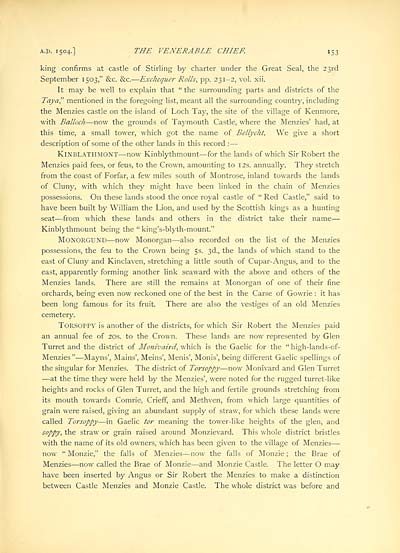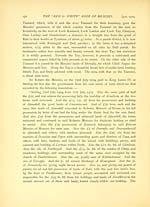Red and white book of Menzies
(213) Page 153
Download files
Complete book:
Individual page:
Thumbnail gallery: Grid view | List view

A.jx 1504.] THE VENERABLE CHIEF. 153
king confirms at castle of Stirling by charter under the Great Seal, the 23rd
September 1503," &c. &c. — Exchequer Rolls, pp. 231-2, vol. xii.
It may be well to explain that " the surrounding parts and districts of the
Taya," mentioned in the foregoing list, meant all the surrounding country, including
the Menzies castle on the island of Loch Tay, the site of the village of Ken more,
with Balloch — now the grounds of Taymouth Castle, where the Menzies' had, at
this time, a small tower, which got the name of Bellycht. We give a short
description of some of the other lands in this record : —
KlNBLATHMONT — now Kinblythmount — for the lands of which Sir Robert the
Menzies paid fees, or feus, to the Crown, amounting to 12s. annually. They stretch
from the coast of Forfar, a few miles south of Montrose, inland towards the lands
of Cluny, with which they might have been linked in the chain of Menzies
possessions. On these lands stood the once royal castle of " Red Castle," said to
have been built by William the Lion, and used by the Scottish kings as a hunting
seat — from which these lands and others in the district take their name —
Kinblythmount being the " king's-blyth-mount."
MONORGUND — now Monorgan — also recorded on the list of the Menzies
possessions, the feu to the Crown being 5s. 3d., the lands of which stand to the
east of Cluny and Kinclaven, stretching a little south of Cupar-Angus, and to the
east, apparently forming another link seaward with the above and others of the
Menzies lands. There are still the remains at Monorgan of one of their fine
orchards, being even now reckoned one of the best in the Carse of Gowrie : it has
been long famous for its fruit. There are also the vestiges of an old Menzies
cemetery.
TORSOPPY is another of the districts, for which Sir Robert the Menzies paid
an annual fee of 20s. to the Crown. These lands are now represented by Glen
Turret and the district of Monivaird, which is the Gaelic for the " high-lands-of-
Menzies" — Mayns', Mains', Meins', Menis', Monis', being different Gaelic spellings of
the singular for Menzies. The district of Torsoppy — now Monivard and Glen Turret
— at the time they were held by the Menzies', were noted for the rugged turret-like
heights and rocks of Glen Turret, and the high and fertile grounds stretching from
its mouth towards Comrie, Crieff, and Methven, from which large quantities of
grain were raised, giving an abundant supply of straw, for which these lands were
called Torsoppy — in Gaelic tor meaning the tower-like heights of the glen, and
soppy, the straw or grain raised around Monzievard. This whole district bristles
with the name of its old owners, which has been given to the village of Menzies — ■
now " Monzie," the falls of Menzies — now the falls of Monzie ; the Brae of
Menzies — now called the Brae of Monzie — and Monzie Castle. The letter O may
have been inserted by Angus or Sir Robert the Menzies to make a distinction
between Castle Menzies and Monzie Castle. The whole district was before and
king confirms at castle of Stirling by charter under the Great Seal, the 23rd
September 1503," &c. &c. — Exchequer Rolls, pp. 231-2, vol. xii.
It may be well to explain that " the surrounding parts and districts of the
Taya," mentioned in the foregoing list, meant all the surrounding country, including
the Menzies castle on the island of Loch Tay, the site of the village of Ken more,
with Balloch — now the grounds of Taymouth Castle, where the Menzies' had, at
this time, a small tower, which got the name of Bellycht. We give a short
description of some of the other lands in this record : —
KlNBLATHMONT — now Kinblythmount — for the lands of which Sir Robert the
Menzies paid fees, or feus, to the Crown, amounting to 12s. annually. They stretch
from the coast of Forfar, a few miles south of Montrose, inland towards the lands
of Cluny, with which they might have been linked in the chain of Menzies
possessions. On these lands stood the once royal castle of " Red Castle," said to
have been built by William the Lion, and used by the Scottish kings as a hunting
seat — from which these lands and others in the district take their name —
Kinblythmount being the " king's-blyth-mount."
MONORGUND — now Monorgan — also recorded on the list of the Menzies
possessions, the feu to the Crown being 5s. 3d., the lands of which stand to the
east of Cluny and Kinclaven, stretching a little south of Cupar-Angus, and to the
east, apparently forming another link seaward with the above and others of the
Menzies lands. There are still the remains at Monorgan of one of their fine
orchards, being even now reckoned one of the best in the Carse of Gowrie : it has
been long famous for its fruit. There are also the vestiges of an old Menzies
cemetery.
TORSOPPY is another of the districts, for which Sir Robert the Menzies paid
an annual fee of 20s. to the Crown. These lands are now represented by Glen
Turret and the district of Monivaird, which is the Gaelic for the " high-lands-of-
Menzies" — Mayns', Mains', Meins', Menis', Monis', being different Gaelic spellings of
the singular for Menzies. The district of Torsoppy — now Monivard and Glen Turret
— at the time they were held by the Menzies', were noted for the rugged turret-like
heights and rocks of Glen Turret, and the high and fertile grounds stretching from
its mouth towards Comrie, Crieff, and Methven, from which large quantities of
grain were raised, giving an abundant supply of straw, for which these lands were
called Torsoppy — in Gaelic tor meaning the tower-like heights of the glen, and
soppy, the straw or grain raised around Monzievard. This whole district bristles
with the name of its old owners, which has been given to the village of Menzies — ■
now " Monzie," the falls of Menzies — now the falls of Monzie ; the Brae of
Menzies — now called the Brae of Monzie — and Monzie Castle. The letter O may
have been inserted by Angus or Sir Robert the Menzies to make a distinction
between Castle Menzies and Monzie Castle. The whole district was before and
Set display mode to:
![]() Universal Viewer |
Universal Viewer | ![]() Mirador |
Large image | Transcription
Mirador |
Large image | Transcription
Images and transcriptions on this page, including medium image downloads, may be used under the Creative Commons Attribution 4.0 International Licence unless otherwise stated. ![]()
| Histories of Scottish families > Red and white book of Menzies > (213) Page 153 |
|---|
| Permanent URL | https://digital.nls.uk/96655288 |
|---|
| Description | A selection of almost 400 printed items relating to the history of Scottish families, mostly dating from the 19th and early 20th centuries. Includes memoirs, genealogies and clan histories, with a few produced by emigrant families. The earliest family history goes back to AD 916. |
|---|

